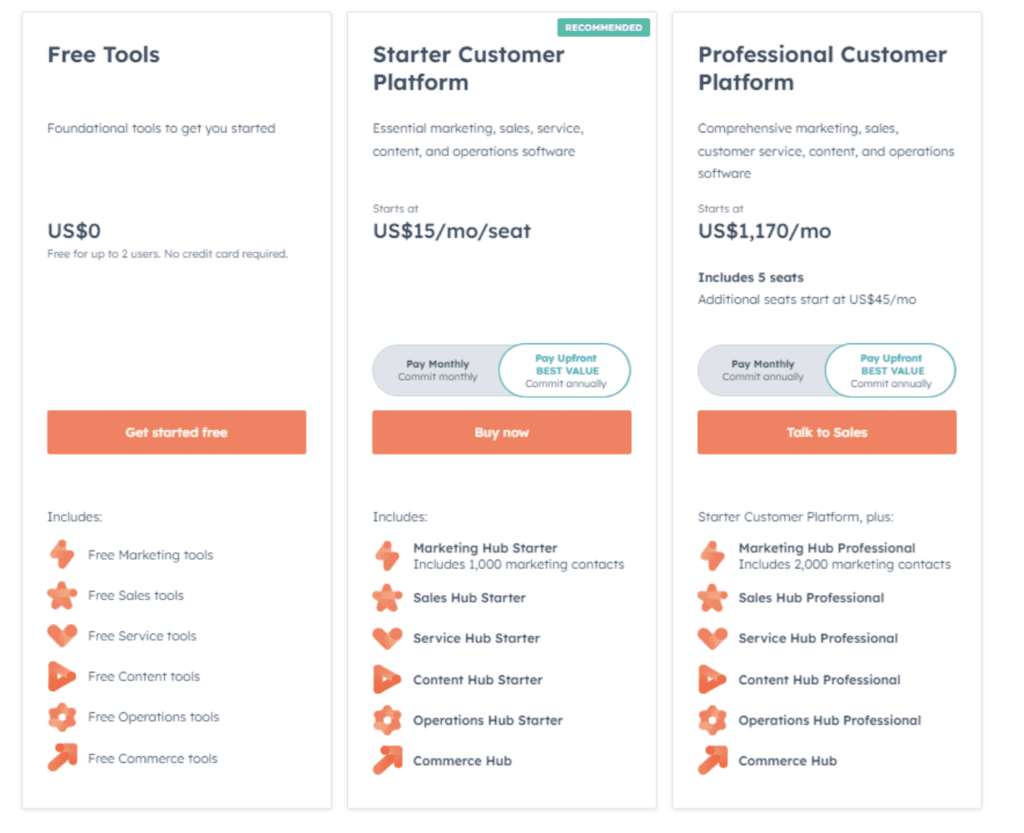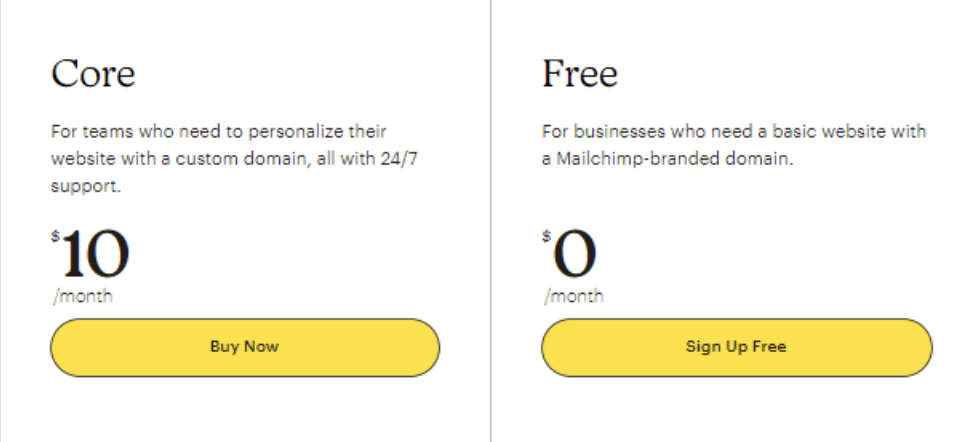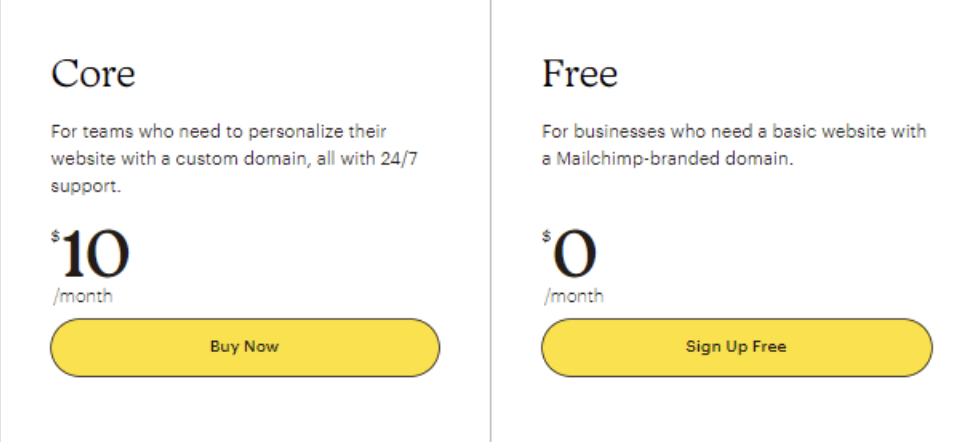
HubSpot vs Mailchimp: Choosing the Right CRM System in 2024
October 14, 2024Work smarter, not harder. This maxim has never been more relevant than in 2024. The meteoric rise of e-commerce has resulted in massive business opportunities. Both small and large companies are scrambling to make the most of these opportunities. And helping them along are CRM systems.
Since you are here, you probably have questions about CRMs. You might be wondering which CRM is the best for your business. You may also be wondering which CRM provides the most features for the lowest price.
During your research, you must have definitely heard about HubSpot and Mailchimp among others. You may have also heard that CRMs boost performance and productivity. Some studies claim that using CRM results in a 29% boost in sales.
Today, we will look at HubSpot and Mailchimp, two popular CRMs, and how they stack up against each other. Since I have used both of these platforms extensively, my analysis of them is backed not only by research but also by my own experience.
After reading this comparison, you will be able to understand which CRM suits you better.
Overview of Both Tools
At its core, HubSpot is a CRM tool that covers marketing, content management, customer service, and even sales management.
Mailchimp, on the other hand, offers email marketing as its primary service. The other services it does provide are not fleshed out enough to be compared to other tools like HubSpot.
Before you dive into HubSpot and Mailchimp, you should consider Flatlogic, a better alternative tailored to your unique business needs. Without the usual scalability issues, Flatlogic excels at delivering custom business software with full code ownership and extensive customization capabilities. This makes it an excellent choice for businesses that need specific, customized functionality in their ERP, CRM, or other administrative systems.
However, the discussion of Flatlogic as a CRM is beyond the scope of this article, so I will stick to discussing HubSpot and Mailchimp.

How Do the Key Features of Both Toolkits Compare
CRM
CRM stands for customer relations management. A CRM automates and manages most or all customer-facing activities. This includes marketing, sales, and customer support.
HubSpot
HubSpot provides plenty of CRM features and functions. For example, you can create a custom list of contacts that shows all of their relevant information. This can include their email, industry, and role (customer, partner, seller, etc.).
Users can also filter their contacts based on a number of parameters. For example, they can filter based on role, industry, date of becoming a contact, or days since they have been contacted.
Since HubSpot is primarily a CRM, all of this information is available to all your team members. As such, there is no loss of data because all teams and members see the same centralized view of information.
One of the stand-out features of HubSpot CRM is that you can upload CSV (Excel spreadsheet) files that contain your customer’s information, such as their name, email, phone number, and other relevant information. The best thing about it is that HubSpot will automatically import that information into the correct format on its dashboard.
You won’t need to manually enter anything. The data fields in the CSV will be recreated faithfully in the HubSpot dashboard.
You can also create and manage “sales pipelines” that help you manage your ongoing business deals. The sales pipeline keeps a record of your expenses related to a deal and what actions have been taken to move it along.
Mailchimp
Mailchimp is not a CRM. It is an email marketing tool. It has tried to expand itself into the CRM role, but it does not provide nearly enough functions and features to classify it as a proper CRM. At best, we can define it as an email marketing tool that has some functions of a CRM.
Mailchimps CRM capabilities are limited to:
- Creating contacts
- Sorting contacts
- Importing contact lists from CSVs
- Creating embedded forms
So, HubSpot has a clear advantage over Mailchimp in this regard.
Both HubSpot and MailChimp offer advanced email builders that are quite easy for a non-technical person to use. There are plenty of prebuilt templates available, and both platforms allow you to customize them to some extent.
I personally feel that HubSpot has the better customization. However, MailChimp offers way more templates right out of the gate. This is a recurring trend because HubSpot is, overall, more complex to use but offers more customizability, while Mailchimp is much simpler in comparison.
Anyway, you get email templates, and you can change design elements like the background, colors of different spots, text size, font, etc.
When all is said and done, emails are ultimately Mailchimp’s forte. So, they provide some extra features. Namely, domain integration.
If you want Mailchimp to send emails on behalf of your domain, you do so via a simple authentication process. All you need to do is go to your ‘account’ click on ‘domains’ and click the “add and verify domain” button. After selecting the domain, you will have to log in once, and Mailchimp will automatically verify your domain and create the relevant DNS records.
You can also do this manually, but more steps are required. The extra steps include creating two CNAME records and one DMARC record. Mailchimp provides the values to create the records, and you just have to paste them into your domain manager, where you create records yourself.
These records propagate within 48 hours, and you can check that yourself with a 3rd party domain propagation checker tool. You can also check whether the published records are correct by doing a CNAME lookup and DMARC record lookup.
HubSpot also allows you to integrate your domain with it, but the process is much simpler, and you have little control over it. In this aspect, Mailchimp is a clear winner.
Automation
When it comes to automation, both suites have some options. You can automate parts of the customer journey, such as email reminders and sign-up forms.
Mailchimp
In Mailchimp, you can automate emails. For example, if you have created a landing page for sign-ups, you can set up an automatic response. As soon as a customer finishes their sign-up, an email will be sent to congratulate them on their sign-up.
You can create and design this email beforehand using Mailchimp’s extensive email creation tools. The automation does not stop there. You can also set up your system to automatically email your clients whenever they take a specific action, such as buying something, leaving a cart unattended for a few hours/days, etc.
The best thing is that the campaign manager lets you create custom emails for different responses.
HubSpot
HubSpot also has sophisticated automation procedures. You can automate most of the customer journey and not have to work too hard on it.
HubSpot lets you create customer lists. These lists are customizable, and you can define which parameters are used to keep certain customers on specific lists.
For example, all customers from a particular region could be on their own list. HubSpot has a feature called “Active lists,” where the list will update on its own if a customer’s data changes. For example, if a new customer who lives in a particular region gets added to a new contact, that customer will be automatically added to the active list of the particular region. So, a customer will automatically start receiving emails if they are added to a particular list.
This means that you don’t have to manually manage lists. All active lists will be managed automatically as long as you have the correct setup.
Integrations
In the modern world, any SaaS tool worth its salt needs to be able to interface and work with other tools. The idea is that two different tools should be able to work together to perform their functions better.
This is commonly done via integrations. Both HubSpot and Mailchimp support integrations. They can be integrated into other tools and vice versa.
So, what kind of integrations do these tools offer, and how does that improve their usage and function? Let’s find out.
HubSpot
HubSpot is a CRM that has a lot of integrations. Many tools and services provide integrations for HubSpot, which allows it to pull data from them seamlessly.
This has the added advantage of getting all of your marketing and sales data in one place. So, even if you have a lot of different services for different parts of your business, HubSpot will use its integrations to provide a consolidated view of all your data.
Some popular HubSpot integrations include:
- Ad platforms like Google Ads and Facebook Ads. Hubspot will pull contact data, conversion rate, click-through rate, and other information to help you oversee your ad campaigns.
- E-commerce platforms like Shopify and Woocommerce. This allows HubSpot to monitor sales, revenue, conversions, and customers.
- Email marketing services like, you guessed it, Mailchimp.
- Other CRMs like Salesforce. This kind of integration allows both CRMs to exchange data and information.
- Data and analytic tools like Google Analytics. This kind of integration allows HubSpot to monitor your website traffic and conversions and create reports based on the data.
Mailchimp
Mailchimp also has plenty of Integrations. Many of them are very similar to HubSpot as well. Some of the popular integrations of Mailchimp are given below.
- E-commerce platforms like Shopify, Woocommerce, and Big Commerce can integrate with Mailchimp to send emails. Mailchimp allows these platforms to run targeted marketing campaigns, send abandoned cart reminders, and send order/payment confirmation emails.
- Analytic tools like Google Analytics can sync with Mailchimp and help track email marketing performance and ROI.
- CRMs like HubSpot and Salesforce can integrate Mailchimp to share customer data (remember Mailchimp also has contact lists) and sync and track marketing efforts.
- Integrates with Facebook and Instagram. This allows Mailchimp to import contacts, track Ad performance, and, of course, run an email marketing campaign.
- Event Management tools like Zapier and Eventbrite can integrate with Mailchimp. This makes it easier to create custom workflows and send follow-up emails to event attendees.
These are just some of the integrations supported by both HubSpot and Mailchimp.
Landing Pages
Landing pages are the very first web pages that a person sees when visiting a website. Since they cast the first impression, they need to be extremely good.
Both HubSpot and Mailchimp provide drag-and-drop landing page builders. Using these tools, anyone can create a professional-looking, well-designed landing page.
You can choose from several templates and then customize them to your liking. Both toolkits also provide A/B testing for landing pages. You can also create lead-capturing forms and integrate them with the CRM features of the toolkits.
So, what are the differences? Well, for starters, HubSpot is more sophisticated. HubSpot provides a better version of all the features we discussed just now. The actual differences are given below.
| HubSpot | MailChimp |
| Has less Templates | Has more templates |
| Provides more customization features | Has fewer customization options |
| Has better integration of lead-capturing forms with CRM. | Has limited integration of lead-capturing forms with CRM |
| Has better A/B testing for landing pages | Most A/B testing features are for comparing emails rather than landing pages. |
| All templates are mobile-optimized | All templates are responsive. However, in-depth optimization for mobile is limited to certain templates. |
| Different features are locked behind higher-tier paid plans | All features available in all plans (Including free plan) |
Analytics and Reporting
Analytics and reporting are crucial features of CRMs. Without them, it is very difficult to understand what your data means. Data that does not give you any insight is all but useless. That’s why reporting and analytics are such core features of any respectable CRM.
Naturally, HubSpot has the advantage here as it is a bonafide CRM, while Mailchimp is an email marketing solution.
Let’s take a look at HubSpot reporting features first.
HubSpot
HubSpot has a centralized view of all your data, which makes it easy to understand the relationship between different data types. Here are the types of information it shows.
- Performance metrics of all your campaigns
- Email stats like open rate, unsubscribe rate, conversions, and deliverability.
- Landing page stats like form submissions, page views, conversions, and bounce rate
- Total conversions from each marketing venture (i.e., email, ads, blogs, social media)
- Funnel reporting, i.e., which contacts are at which stage of the funnel.
- Ad impressions, clicks, and ROI
- Website analytics include traffic, new visitors, returning visitors, top-performing pages, and average session duration.
- Consolidated stats like customer lifetime value.
- Extensive A/B testing reports.
- It can also integrate with other analytical tools as well.
These are all really good stats that can help a business identify the most profitable revenue sources.
Now, let’s look at Mailchimp.
Mailchimp
Mailchimp has most of the reporting features of HubSpot, but they focus on email marketing. That’s why its reports are not as comprehensive as those of HubSpot.
For those who are curious, MailChimp provides reports on the following things.
- Email open rate, click-through rate (CTR), deliverability, bounce rate, and unsubscribe rates in individual campaigns.
- Audience information includes new subscribers, most engaged customers, geographic regions, and demographics of customers.
- A/B testing reports that show which variants of emails performed better with respect to open rates, CTR, and conversions.
- Simplified landing page performance reports that include page views, signups, and conversion rates.
- Facebook and Instagram campaign reports that include impressions, clicks, and conversions.
- Basic Ad Reporting
- Limited webpage performance reports that include page visits, heat maps, and top-performing links.
From these points, it is easy to gather that HubSpot provides multi-channel reports while Mailchimp is mostly focused on email marketing.
Social Media
As I already mentioned before, both Mailchimp and HubSpot have integrations that allow them to pull data from social media sites. This data is used in analytics and reporting.
As you know, there are multiple social media sites. HubSpot and Mailchimp do not support pulling data from all of them. They can pull data via integrations from a select few platforms.
Let’s look at which platforms they support and what kind of data they can get from them.
HubSpot
- Supports LinkedIn, YouTube, Facebook, Instagram, and X
- Allows you to create and make posts through HubSpot’s interface.
- Supports managing and interacting with all posts from HUbSpot’s interface.
- It supports the scheduling of posts, i.e., you create the posts and schedule them to be published at a later time or date.
- It supports tracking posts made outside of HubSpot’s interface.
- Reporting and analytics of social media posts.
HubSpot’s social media features are so extensive that they are only available in the premium plans.
Mailchimp
Mailchimp does not have as extensive support for social media as HubSpot. It supports fewer platforms and has limited functions associated with social media. They are so limited, in fact, that Mailchimp offers them in the free plan and doesn’t even mention the upgrades in the premium plans.
Here are the notable features of Mailchimp’s social media toolkit.
- Supports Facebook, Instagram, and X
- Allows you to create posts and publish them across all supported platforms from Mailchimp’s interface.
- Supports scheduling but only in paid plans
- Basic reporting about post impressions and clicks
And that’s about it. It is evident from this list that social media management was never Mailchimp’s primary concern, which is why there are so few features for it.
AI Features
Now, let’s see how both toolkits use artificial intelligence to improve their working.
Both toolkits use generative AI for content creation. HubSpot has a whole list of tools dedicated to all kinds of content creation and optimization. You can use HubSpot’s generative AI to write, change tone, shorten, or paraphrase any type of content. Common examples include blog posts, social media posts, emails, and even ad copy. Naturally, this also means that you can use it to write and improve your landing page content.
Mailchimp, on the other hand, only allows you to use generative AI in its email builder. You can’t use it on landing pages or social media posts. It also offers functions similar to those of HubSpot, i.e., you can create, edit, improve, or change the tone of the email content.
That’s about it for the interactable AI features.
Pricing Models
Now, let’s take a look at the different pricing models of both toolkits.
HubSpot
HubSpot has a flexible pricing structure. You can buy individual products, or you can buy them in bundles, depending on your usage. To get the complete functionality of a CRM, you will need to buy one of the bundles.
There are five pricing tiers for the “Customer Platform” (that is, the CRM bundle). Three of them are included in the “For Individuals and Small Teams” sections, while two are in the “For Businesses and Enterprises” section.
Let’s check them out.
Individuals and Small teams

For Businesses and Enterprises

MailChimp
Mailchimp does not provide bundles of products like HubSpot. Instead, they have three categories called:
- Email marketing
- Websites
- Transactional Email
You have to pay for every product if you want to use them. The good thing is that they are very cheap (compared to HubSpot). Here are the prices for all of the premium plans.
Email Marketing

Websites

Transactional Emails

Pros & Cons
Now that we know the pricing and features of both Mailchimp and HubSpot, I think it’s time to learn their pros and cons.
HubSpot
| HubSpot Pros | HubSpot Cons |
| HubSpot is a comprehensive, all-in-one platform. | It is quite costly, especially for plans with advanced features and scaling. |
| Provides deep integration between marketing, sales, and service. | Due to more features and functions, it has a steeper learning curve for new users. |
| Has advanced automation and reporting tools. |
MailChimp
| Mailchimp Pros | Mailchimp Cons |
| It is quite easy to use, especially for beginners in email marketing. | Has quite limited CRM and sales management features. |
| Has very affordable pricing for smaller businesses. | The automation and reporting features are less sophisticated than those of HubSpot. |
| Seamless integration with e-commerce platforms | Unsuitable for large businesses and enterprises. |
Conclusion
HubSpot and Mailchimp are arguably quite powerful tools in their own right. They have their differences, but that is primarily due to their different goals.
Mailchimp’s focus is on ease of use and email marketing. Its target audience is small businesses and teams rather than huge enterprises. That’s why its offerings seem limited in comparison to those of HubSpot.
HubSpot, on the other hand, caters to both small and large businesses. That’s why it offers solutions that can be deployed on an enterprise level. Since such large-scale deployment is costly, HubSpot’s prices are high.
At the end of the day, which tool is better for you depends on your situation. You can start with Mailchimp, and then, as your business grows, you can advance to HubSpot. Since Mailchimp can be integrated with HubSpot, you can keep using it if you like.
However, a better option in the long term is to use a service like Flatlogic to create a custom solution that you can scale with your business. This saves costs, and there is no adjustment period either, so you won’t have to go through a phase of low productivity where your team learns the new CRM.
